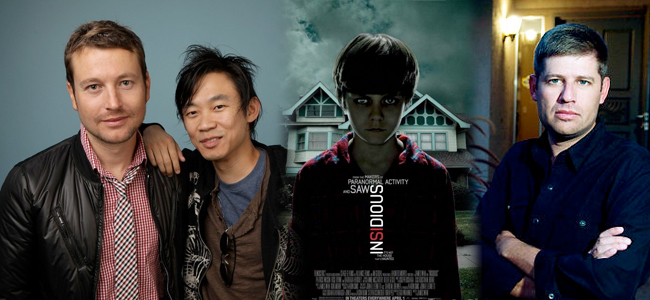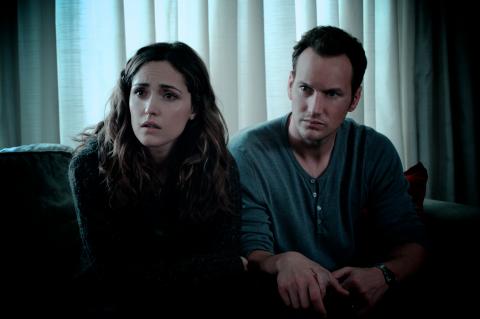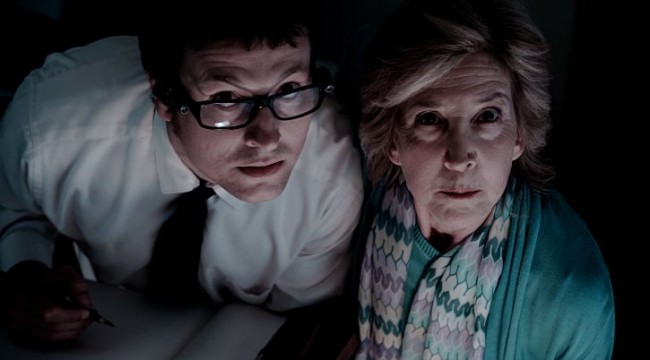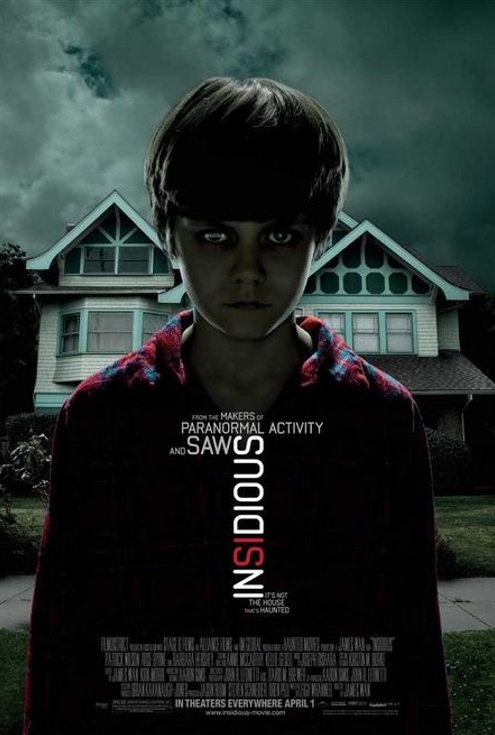
Director James Wan, writer Leigh Whannell and producer Oren Peli are responsible for two of the most successful horror franchises (Saw, Paranormal Activity) in recent memory. In teaming up to make Insidious, an original horror film, they’ve created something of an event for horror-philes. Sitting down with all three of them for an interview only offers a taste of what it must have been like on set. Nevertheless, in support of their new film (check out my review here), which made its U.S. premiere at SXSW, the filmmakers talked franchises, on-screen violence, genre elements and much, much more.
TFS: Leigh, how did the project come about?
Leigh Whannell: The project came about because the producers of Paranormal Activity, Jason Blum and Steven Schneider and Oren Peli, who also directed it, had formed a company in the wake of it. I guess it’s almost required of you if your movie is successful [laughs]. They had some money to make, I think, five horror movies and they had a meeting with us (Leigh and director James Wan) in late 2009. I was getting ready to go back to Australia to hang out with my friends and be on holiday, and we had this meeting and they were like “we want you guys to be the first film on our slate; we wanna work with you guys”.
And James and I had this idea a long time ago, which was sort of the core idea of Insidious and it just became this thing really quickly, like “we should do that idea!”. Next thing I knew two weeks later, I was in Australia writing the script for a project I didn’t know anything about till the two weeks before. By the time I got back from Australia in mid-January, they were already location scouting and it was just such a quick process. But it was good! That energy, that sort of forward momentum, that was so infectious. All of a sudden, there was a production office, there were actors involved; every day there was a new phone call with a surprising new piece of news. It was amazing.
Insidious does not focus on violence as much as Saw. Did you intend to make this different on purpose, to try to scare people in a different way?
LW: We didn’t think of it at the start, it wasn’t like “hey, let’s make a film without blood and guts,” but halfway through the production we realized there was nothing in this film that was pushing towards an R, so we trimmed back some of the stuff that would have done so and that was it.
What were the most challenging aspects of this film?
LW: For me personally, the most challenging was the writing part of it. It wasn’t a pressurized situation where people were looking over my shoulder, but it was a situation where the spirit of the thing between all of us was very much “let’s get this done!”. That’s actually part of what attracted us to it, so I was caught up in this whirlwind of “let’s go out there and make a movie!”. And next thing I know I’m back in Australia, and I’m thinking “damn, now I have to write this film in that spirit.” I can’t sit there for six months to a year going “hmm” and write two words a day. So I was just hammering it out. I remember I was visiting my mom for Christmas, and I would go out and quickly make the rounds, then go right back to the room to write. At like 4 a.m. in the morning, everyone is drunk and full of bad Christmas food, and I was the only one awake in the house, sitting there typing typing typing. It was fun to do it though.
Outside of writing, I think the most challenging aspect of the production was probably trying to get the film to look like a classic horror film on such a low budget. It’s easy to just do the handheld thing because you can get things much faster on little money. In Saw, that handheld style was created only because we had such a small budget. James wanted to control his shots, but by the second day, it was impossible. He edited it in a gritty MTV-style way in order to hide its small budget. For Insidious, I don’t think it would work if it was like that, so it was tough.
How did you decide how the ghosts were going to look?
LW: James loves his dolls, so he wanted the ghosts to be kind of doll-like. I kept the description of the ghosts in the script very spare, and once James got into it, he put his own thoughts and ideas into the look. At first, I thought “hmmm I don’t know” and as I’ve seen the movie, I really like the look once the ending comes around. I think there’s something just macabre about it. The film is so low budget, and I really think it’s a really good-looking film and the people working on it were so good, it’s easy to be fooled into thinking it’s a much more expensive film than it is. And I think James and I always had this mentality that if you don’t have a lot of money to work with, you have to kind of shout to be heard. Put it all in there, use practical effects, still make an interesting film and don’t walk the middle line because you’re afraid that it will look bad. And I wouldn’t have it any other way.
The movies you’ve written that have been made are all in the horror genre. Are you planning to spread out to other genres with your future projects?
LW: I have a fair few other scripts that are not horror that haven’t been produced yet. I’ve got a film in Australia with a friend of mine. I wrote the script with Angus Sampson, who plays the other ghost hunter Tucker in Insidious. He and I have been working on the script for a couple of years; it’s called The Mule about a drug mule. That’s kind of a Trainspotting/Fargo-esque crime dramedy-ishy-thingy and that’s set in Melbourne in 1983. It’s kind of interesting going through the Australian funding process. I did it backwards; I went to Hollywood first and then made an Australian film. I’ve also written a children’s animated film…well I didn’t write it to be animated but the company that optioned it is a company that makes animated films. That’s been fascinating getting a peak into that world. I also wrote a comedy. There’s all these different things in different genres from me that I hope you’ll see in the next year or two. Except for the animated film. You’ll be seeing that in 2015 because it’s a long process. It was fascinating to see how they make their films. So yeah, that’s pretty much it right now.
Where did you guys end up shooting?
OP: On location in Los Angeles. Two separate houses and practical locations.
Oren, how did you come across the project?
OP: After Paranormal Activity was successful, we formed a company to produce the kind of horror movies we would like. We wanted to collaborate with the best horror filmmakers out there and help them make the kind of movies they want outside the Hollywood system; a low budget but also full creative control. James and Leigh were the first people we talked to, and we asked if they were interested, and they gave us the script for Insidious. Four or five months later, we were already shooting. It all just made sense.
How did you get Rose Byrne and Patrick Wilson on board?
OP: James kind of already had the vision of using them, and we approached them. They responded really well to the script, and were good sports, up for anything.
Why do you prefer doing movies with a lower budget?
OP: I’ve never done a movie on a higher budget, and sometimes I look at budgets of movies and they are overwhelming. Like, I don’t even know where the money is going to. To me, it doesn’t make sense to do something with a high budget; if you’re doing something that’s just about the story and the characters, it’s unnecessary. Sometimes when you’re restricted by budget and people aren’t throwing money at you, you are forced to focus on the characters and the story and how you could make those matter the most. If you think about Insidious and the most effective beats, none of them really cost too much money, just good acting and a good script. There’s benefits to being restricted by a smaller budget.
Did you have any input into the film yourself?
OP: The main input I had was getting Insidious made and once production started going, James was on top of everything. We aren’t the kind of producers who have to tell him how to do everything; we just came to the set in case he needed help, but James had everything under control. After the test screenings, we did give some notes, but not a big amount. James should get most of the credit.

Did you find the way Insidious plays risky at all?
OP: Yes because the first half is a slow build and really scary, and then it takes that shift and it was risky because it was very unique and different. But the good thing about it is it takes you somewhere you haven’t been before in a movie. You just don’t know it for a long time.
I’ve seen/read other sites try to ask this, but I figured I’d at least give it a try. Any news on Area 51?
OP: Sorry, no comment [laughs] but nice try.
Considering you’re all responsible for two of the bigger franchises in horror, is there any pressure to turn Insidious into one as well?
OP: I don’t think anyone is thinking about it; we are just focusing on this one. I have a feeling that if it does really well someone is going to bring it up though.
It does leave it open for a sequel somewhat though.
OP: Definitely. And these days, you can find any excuse to make a sequel to anything like an evil twin or something like that. But none of us are thinking of that, we are just looking forward to April 1st when the movie comes out and there’s a conversation about a sequel, it means we’re in a good place and the movie has done well.
Anything you can tell us about the other horror movies you and your partners are producing?
OP: Well I can tell you what’s been publicly announced. There’s a movie called The Bay which Barry Levinson directed and it’s in post-production. The movie we’re going to shoot after that is Lords of Salem with Rob Zombie.
Are you keeping the same role in those like you are in Insidious?
OP: Yes. Like with Lords of Salem, we told Rob that he has full creative control. We’ll be there to support him and he asks for advice, we’ll be happy to help but if not that’s okay.
I asked Leigh the same question, but do you want to stay in the horror realm or do you want to do things outside of the genre?
OP: I do love horror, and I’ve probably will do other things in the genre but eventually I’d like to transition out of it to more traditional filmmaking. But like, who knows? I can say what I would want to do, but you never know how things’ll work out.
How does being a producer feel compared to being a director?
OP: It’s pretty cool; I mean I like the process of filmmaking. I’m not going to just produce full-time or anything, but in situations like this when you get to work with cool creative people like James and Leigh it’s fun to involved with it and not have the pressure and responsibility. Let James worry about everything and I can just hang out and enjoy watching it come to life.
So I would assume that the whole “Saw Vs. Paranormal Activity” thing that many people wrote about was just a good story and not much more?
OP: Absolutely. It was more the rabid fans of both sides wanting to make a big deal of it. Maybe on the business level there was something more, but with the filmmakers, we’re all fine and we get along.
The horror genre repeats itself a lot; do you have any ideas on how the horror genre can change and be different?
OP: If I knew, I’d try to do it [laughs]. There are a lot of sub-genres in horror and they all have their merits and fans. You’ve got the bloodier more violent ones and also the ones like Paranormal Activity and Saw where it’s more of a build up. Those are the movies I personally enjoy more and am more drawn into making. I think you’re always going to have the gory movies getting done, but I think there will be more of a shit towards Hitchcock-style movies where it’s more story-driven. I hope it goes more in that direction anyway, I think that’s a big chunk of the market that isn’t currently being tapped.
James, did you find the low-budget affecting the way you approached making Insidious?
JW: I actually went in wanting to make it low-budget. I didn’t want to funnel it through the studio system, because we wanted creative freedom to tell the story we wanted to tell. If I had funneled it through the studio system, I probably would have made a very different film; I’m not saying for better or for worse, but it would have had a very different flavor to it. And I wouldn’t have had the chance to do a lot of things, like get to edit the film myself which is something I wanted to do.
I actually edited the film in my bedroom. Talk about low-budget filmmaking. My assistant editor was first set up in my garage but it got really cold and we had to set him up in my kitchen. I just think of how funny it is; it’s a grassroots, student film-style filmmaking, which I love. I wanted to go back to my roots again, so to speak.
I had read a previous interview with you before where you had said you had made Insidious without the violence as a way to combat how gory the horror scene has been.
JW: Yeah, and I guess I have a lot to do with that [laughs]. But the thing was, people forget that the first Saw was not that violent and was more psychological. It wasn’t until the sequels and the imitators came out that it became more about that, and I made Insidious to prove to people it’s still possible to make scary, suspenseful movies without blood and guts. And that was really my aim as a director, to make a movie that was consciously in that world.
Can you talk about your influences when choosing the score?
JW: For me, visual is very important but so is the soundscape in my movies. Especially if you’re making a movie without a lot of violence and action, you need to make it up somewhere else. With Insidious, I really wanted a musical score that harkened back to the old school horror films, with a lot of piano and shrieking violins. If anything, a lot of the influences for the score were more from avant-garde classical composers like Krzystztof Penderecki and George Crumb, very much in that realm. I wanted a score that was very unsettling, not something melodic, and I think the score helps set a lot of the tone for the movie especially since you don’t really see much happening.
But what about Tiny Tim?
JW: The first time I ever heard “Tip Toe Through the Tulips,” I thought to myself “wow, that’s serial killer music!.” He’s a very benign guy but his whole image to me was creepy. That whole image influenced by want to put it into a movie and use it in sort of a contrasting way. Like, you have this high falsetto happy music set against this really disturbing imagery of a ghost of a little kid dancing. It’s stuff like this I can get away with because of the low budget, otherwise I couldn’t get away with stuff like that.
So you love low-budget filmmaking and would never do a big budget movie?
JW: No, I want to make my big budget Michael Bay film [laughs]. And for something like Insidious, you don’t need a big budget to tell the story. It’s the wrong approach. For Leigh and I, it’s about what we think is right for the film. If you’re making a movie that is ultimately set in two houses, a low budget is fine, but for something like Battle: Los Angeles you would need the higher budget.
Insidious is a far more different film than what the trailer makes it look like it’ll be. It’s more of a slow burn, are you worried this style will sort of alienate the current horror fanbase that’s used to the more A.D.D. style?
JW: I think generally trailers are hard to cut, especially with something like this. You can’t really show the slow burn in a trailer. I do actually think that the trailer does a really good job at showing it. Trailers nowadays cut to things really quick and give almost everything away, and I’m glad the one for Insidious doesn’t. I think the slow burn at the start is very important to suck you into the story and when you start to see the creepy shit, that is how you make it effective.
And you’re right, today’s younger generation do have issues with that. They grow up with things that are so fast-paced, things like YouTube and the Internet, and today’s movies are more geared to the A.D.D. generation. And people get used to that. It’s like with the seven Saw films; if a kid saw the first one when he was 13, then he grew up on that style and assumes horror movies should be like that.
James, you signed a deal with Icon Entertainment for eight movies. Are they all going to be horror, or are you using this as a chance to expand out?
JW: I’m more producing them, so they will be in line with the sort of horror “brand” I’ve kind of made for myself. They wouldn’t necessarily be all horror, but they will be genre films. I want to make fun films whether or not I get to direct them.
So it’s not necessarily eight movies you’re directing?
JW: No, but if I come across something that’s too good to give up to anyone else, then I’ll definitely take it.
Insidious opens everywhere April 1, 2011.

